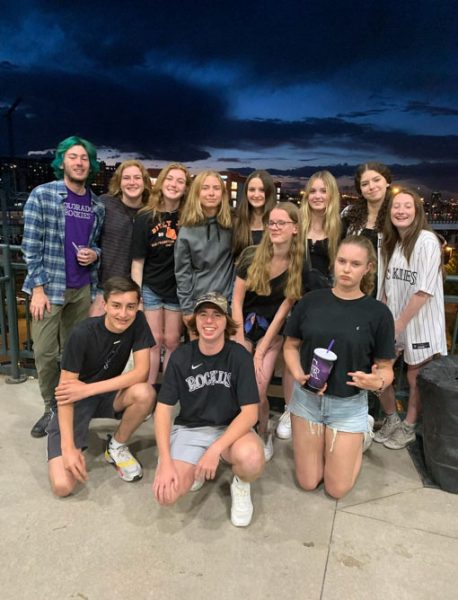Amendment 64 Campaign to Regulate Marijuana becomes a reality
The initiative to regulate marijuana in Colorado began about seven years ago when “Regulate Marijuana Like Alcohol” campaign began. On November 6, 2012, Amendment 64 was passed with 55.32 percent of the ballots, allowing people age 21 and over to use marijuana with regulation, as well as allowing the cultivation and manufacturing of marijuana in a similar way alcohol is.
In 2007 Regis Jesuit graduates Christian Sederberg ’96, Joe Megyesy ’96 , and Philip Snow ’94 as well as many others began the “Campaign to Regulate Marijuana Like Alcohol,” a campaign to regulate the use of marijuana like alcohol. The inspiration came from the group’s desire to educate people on the relative dangers of alcohol and marijuana and to forge a new path for marijuana in the United States where possession has been illegal since the “Marihuana Tax” of 1937.
Sederberg’s business partner, fellow attorney Brian Vicente co-authored amendment 64 together with author Steve Fox who is the head of the firm’s government relations, and a co-founder of the National Cannabis Industry Association.
“Colorado was best situated to do it. With this we had the support from several national drug policy groups and ultimately we got the funding to promote the marijuana policy project,” Sederberg said.
Even before the legislature had written any of the bills that will define the enforcement of Amendment 64, Governor John Hickenlooper required that an “Amendment 64 Task Group” brainstorm ideas for the laws to be written. Twenty four team leaders were chosen by the state to spearhead the project, Sederberg among them.
Meetings between the groups began in December 2012 and lasted until February 2013. A very lengthy report of recommendations for potential laws from the group was published in early April of 2013. The Colorado House of Representatives and Senate then wrote and passed bills to govern the marijuana retail business establishments that will be coming. After clearing the legislature, the bills were signed into Colorado Law late spring 2013, notably House Bill 1317 and Senate Bill 283.
Vicente-Sederberg Associates played a pivotal role in lobbying the retail marijuana bills through government legislature and the firm still continues to advise the state as it grapples with marijuana rule-making. Andrew Livingston, a policy analyst for the firm, worked to plan marijuana production in the state over the next two years.
Critics of the amendment question the motivations of its proponent. The Vicente-Sederberg law firm spends much of their time educating the public on what they believe are widespread misconceptions. For them, it’s about education.
“If I wanted to get marijuana, I would have had no problem getting marijuana since I was 14 years old. This [amendment] has nothing to do with getting high,” Sederberg said.
“My main motivation for ending the marijuana prohibition, has been the idea of freedom. Liberty. I think basically people should be able to do whatever they want as long as they are not hurting or impinging on anyone else’s freedom,” Megyesy said.
Megyesy sees marijuana regulation as a social justice issue.
“The drug war disproportionately affects people of color and minorities. We are incarcerating people in the United States at a far higher rate than anyone in the world. Many of these arrests are drug related crimes, and we are not treating these people who have addiction problems or mental health issues with compassion; we are just locking them up and throwing away the key,” he said.
“We are not trying to provide them with any treatment or help in any of these cases; instead, we are just putting them behind bars.”
Megyesy believes legalization of marijuana will also curb violence in the drug trade.
“The United States is the number one drug consuming country in the world, yet we do not want to make them legal in any way. We would rather funnel such large amounts of money into the hands of these evil violent organizations. It is immoral to continue that,” Megyesy said.
The firm ultimately seeks Federal regulation of recreational marijuana. For many years, almost all marijuana arrests have occurred at the state or local level and U.S. Deputy Attorney General James Cole recently acknowledged that it may be more effective for the states to regulate marijuana laws and be responsible for the local populations.
“That’s how we treat alcohol, tobacco, and firearms. ATF is a federal agency that helps states enforce their laws. Marijuana regulation can operate from the same model,” Sederberg said.
“We want other states to take the lead, and now that the floodgates have opened the tipping point has happened: 58 percent of Americans now support marijuana legalization, according to a 2013 Gallup poll. I think you will see more states legalize marijuana in the next two years, and in the next 5 to 10 years – who knows how many. Hopefully we get to the tipping point of 50 percent of the states or 50 percent of the US population, and that allows a congressional move or a Supreme Court case,” Sederberg said.
According to the 2013 Gallup poll, 67 percent of 18 to 29 year-olds support the legalization of marijuana.
Sederberg anticipates a huge cultural shift in the next decade.
“My expectation is that legalization of marijuana will cause a wide range of reactions from teenagers. When I was in high school some of the people liked marijuana because it was illegal, and some other people simply liked the way it made them feel. There were some others that used it as a crutch to help them with whatever they were dealing with in their life. I think you are going to have all types of different reactions once it is actually legal,” he said.
Implicit in the “Regulate Marijuana Like Alcohol” campaign is the idea that marijuana is not a gateway to drugs like heroin and LSD but instead a social drug similar to alcohol.
But opponents of legal marijuana regulation disagree. Recent studies that show that marijuana can have dangerous effects on the mental health and brain function in adolescent teens.
What is marijuana?
Marijuana is made up of over 500 different chemicals, each of which have different effects on the brain and immune system. Research shows there are two main cannabinoids. A compound called tetrahydrocannabinol or THC, a strong cannabinoid, and the main source of marijuana’s intoxicating effects. Cannabinol or CBD, is the second compound, and is a non psychotropic ingredient.
When these ingredients are delivered into the bloodstream, these compounds shift the communication between the brain neurons, resulting in alterations in mood and cognitive ability that last for several hours.
U.S. school survey data (Johnston et al., 2008) shows that 15 percent of 8th graders have tried marijuana at least once and 43 percent have tried marijuana by 12th grade. Another national survey also reported a history of cannabis use in approximately 45 percent of 12th graders in the U.S., with 5 percent reporting current daily use (Terry-McElrath et al., 2005). Further, other studies support the hypothesis that adolescent cannabis use is a gateway to illicit drug use in early adulthood (Fergusson et al., 2006; Luengo et al., 2008).”
Although the experience of a marijuana ‘high’ is quite temporary, new research shows that frequent adolescent marijuana may lead to further dependence on the drug.
The research, conducted by the University of Maryland School of Medicine, deduced that cannabis use in teenagers effects the brain’s cortical oscillations, in other words, it affects how the brain’s neural sensory communicates.
Elizabeth Starez, a pediatrician at Cherry Creek Pediatrics in Denver, Colorado has clinical experience with dealing with adolescent marijuana use.
“Kids who smoke pot and have a genetic disposition for schizophrenia are much more likely to suffer a schizophrenic break during teen years than kids with the same genetic make up who do not smoke pot. The same is true for depression,” Starez said.
“Marijuana sedates you, life becomes dull, there is no excitement, you become boring- Marijuana is as bad for a developing teenage brain as alcohol and other drugs,” Starez said.
Teenagers are more vulnerable to this problem and can exhibit irritability, anxiety, changes in mood, sleep and appetite.
A recent study made by Duke University showed that marijuana can have detrimental affect on a persons IQ.
“It costs you 8 IQ points ( No big deal if you are a genius, 172 versus 180 is not so bad, but if you are an average Joe Blow with an IQ of 100, the result is 92, which is close to mental impairment,” Starez said.
The Vicente Seberberg Law Firm is aware of the opposite perspective many people may have about the adolescent impact the Regulate Marijuana Like Alcohol Campaign is inhibiting. They believe that educating the public about the truth of marijuana is the first step, and is highly critical to the new cultural changes of the state.
“Education of all members of society regarding the proper use of marijuana is likely to benefit our state while helping to solve certain social justice issues and preserve individual liberty. We believe that the end result will be good for our state,” Sederberg said. “I think that the most important part from a cultural standpoint is that adults, whether they like it or not, will have to have honest conversations with teenagers about marijuana instead of trying to lump it together with some other types of drugs.”








